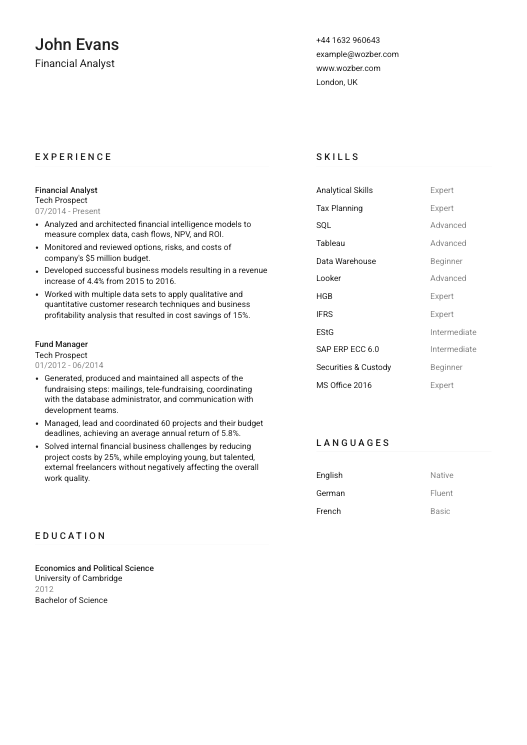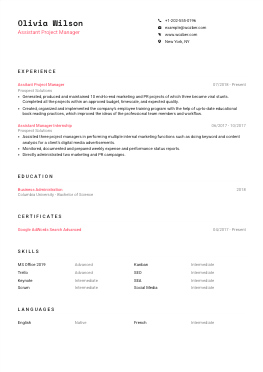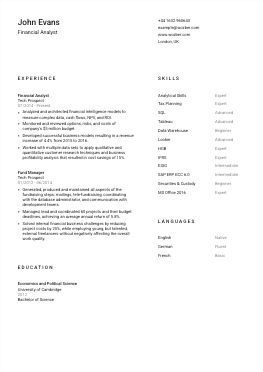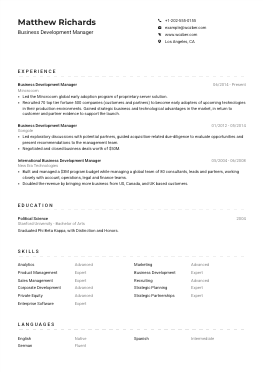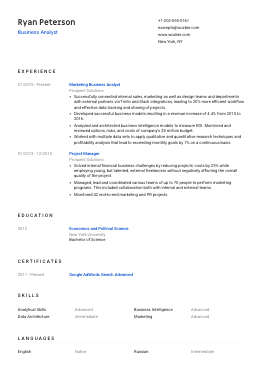The average job opening attracts 250 resumes, and only 2% of applicants get called for an interview. Being competition that high, you have to show to a company clearly that you perfectly fit their specific business needs, and one of the most effective ways to land a job interview is through a modern, targeted resume.
At Wozber, we've been gathering the best resume practices from career experts and successful job seekers for half a decade. And now, we'd like to share them with you in this definitive guide.
If you don't feel like reading, save your time and use our targeted resume builder for free. It has all the best resume writing practices built in.
On this guide:
Chapter 1: The Best Resume Format and Template
Before we jump into all the resume writing specifics, let's examine what content your resume should include and how it should look like.
The best architectural structure
There are quite a few ways to present your information, but a chronological resume is the most common structure. It displays a timeline of your work experience with brief explanations for every job position, highlighting your most relevant accomplishments.
The resume's key topics comprise:
- Job position title
- Contact information
- Experience
- Education
- Skills
- Languages
- Certifications
As you can see in the resume template above, all the topics are presented in a logical order. Experience is always listed before education because job-related content is more relevant than academic achievements.
Also, the skills and languages should be completely separate from the experience and education sections because it presents information in single words, not in sentences.
Every additional topic takes attention away from these main sections, so you shouldn't overload your resume with unnecessary content. Consider leaving out topics like objective, hobbies or programs for discussing in a job interview.
Aesthetically pleasing design
The primary goal of resume design is to make your resume easy to read and guide recruiter to essential parts about you.
Aesthetic design connotes a clean presentation of key sections and content, so it shouldn't be too cluttered or include unrelated background pictures, tables or diagrams. Any unnecessary elements just overload the resume and distract recruiter from more relevant information like experience and skills.
Here are some modern, minimalistic resume templates that you could use:
Chapter 2: Applicant Tracking Systems and a Targeted Resume
It is common practice to write one generic resume and send it to as many different companies as possible. However, this usually leads to no replies because your resume becomes irrelevant.
To fully understand the reasons behind some of the best resume writing practices, first, you should know how a hiring process works.
Companies hire new staff to fill specific needs. A hiring manager will search for the most professional candidate whose resume exhibits a profile she/he deems most relevant to those needs. The problem is, too many people often apply for the same position, many without the required skills or experience. Others may have the skills and experience, but their resumes do not reflect the fact.
Due to the overwhelming number of job applications recruiters receive, companies have started using a type of software to make a hiring process easier – an Applicant Tracking System (ATS). This is how an ATS works:
- A resume goes through an automated scanning process, which extracts text from the document.
- The program separates text into the most common categories: experience, education, skills, and contact information.
- The ATS then compares the skills and keywords indicated by the employer to the skills and phrases found in the resume.
- It then scores the resume on relevancy.
- Only then does a hiring manager begin sifting through the applications.
Most irrelevant resumes are rejected without even a glance from an actual human being. An HR manager examines only those resumes to which the ATS assigns the highest relevancy scores. The recruiter will spend the first seconds to make a yes/no decision by scanning for essential keywords. If they appear in your resume, she/he will give it more attention. If the clues add up to more relevant information, a recruiter will consider you as a potential candidate and put your resume in a short-list folder. Later, the resumes in this folder will be examined much more in-depth. Almost all of these chosen candidates – if you do everything right, including you - will receive a call.
So, all you need to do is make sure your resume stands out from the swirling mass of irrelevant resumes. It should advertise you as a problem-solving candidate that matches the company's requirements. You can achieve this by dropping the right hints and presenting your information in a focused manner.
Resume relevancy is the ultimate goal that will lead you to a job interview. So, instead of sending generic resumes to hundreds of companies, rather concentrate on the ones that appeal the most to you. Which industries do you like? Which companies attract your attention? Do you prefer small startups or big corporations?
Once you find the companies you like, start creating dedicated resumes to each one of them, adjusting your experience and skills to match the different job requirements. This process in general means resume targeting. You will learn in detail how to target your resume in the next chapters.
- Targeted resume is a document that is created in response to a specific job opening.
- Resume targeting is a process of matching your resume content to the job requirements of a specific job opening.
For now, remember – no one will ever read an irrelevant resume. Make yours relevant or in other words – targeted. If you want to make this process easier, use our targeted resume builder.
Chapter 3: Personal Details
Every resume starts with your contact information. It provides an easy way for recruiters to identify you and reach out to you.
The top part of your targeted resume should have the following:
- Your full name
- Job position title (the one that is provided in a job ad's headline)
- Phone number and email address
- A personal website (if it is relevant to a job position)
- Your location (city and country)

Avoid writing Objective and Summary Statements
Objective or summary statements do not provide any additional value to a recruiter, take precious space in a resume and usually merely repeats the information already provided in a resume. That's why we recommend you not to include them. It's too easy for these to be generic or simply to repeat the content of your resume.
Other information to avoid
A recruiter has to make a decision based on your skills and experience. That's why you shouldn't include any information that could lead to recruiting discrimination, such as:
- Your birthday
- Gender
- Marital status
Your photo
There are two camps: one that says you need a photo in your resume and the other that says you shouldn't include it.
If the employer later interviews you but doesn't hire you, it opens the possibility of a discrimination claim. Some companies will even flat out reject resumes with photos just to avoid that potential accusation. That's one reason that some ATS solutions remove pictures from resumes, leaving only the text.
The camp that is in favor of including a photo in the resume says that experts worry too much. Trying to get acquainted with a person without knowing what he/she looks like goes against nature. For example, LinkedIn profiles without photos are the ones that are viewed as unprofessional.

If you choose to include a photo in your resume, its style should comply with the company's values and culture.
We recommend that you have two separate photos – one formal photo and one informal photo. Use a formal photo if the company is a big corporation that has a more formal environment, and use an informal photo if your desired company has a more relaxed atmosphere. Your photo's background should be clean and uncluttered.
Whatever you choose, either to include a photo or not, don't spend too much time thinking about it - the content of your resume is its core.
General guidelines:
- Include a photo, if you're seeking a job in European countries (except Ireland, UK, Netherlands, and Sweden), China, or Japan.
- Do not include a photo in the USA, Canada, United Kingdom, and Australia.
Chapter 4: Work Experience
The resume experience section is the central part of the resume that recruiters scan to find a relevant candidate. Since it gets the most of attention, you should spend most of your time perfecting it.
What to Include?
List the companies you worked for with the following format:
- Job title
- Name of the company
- Employment dates
- Accomplishment statements
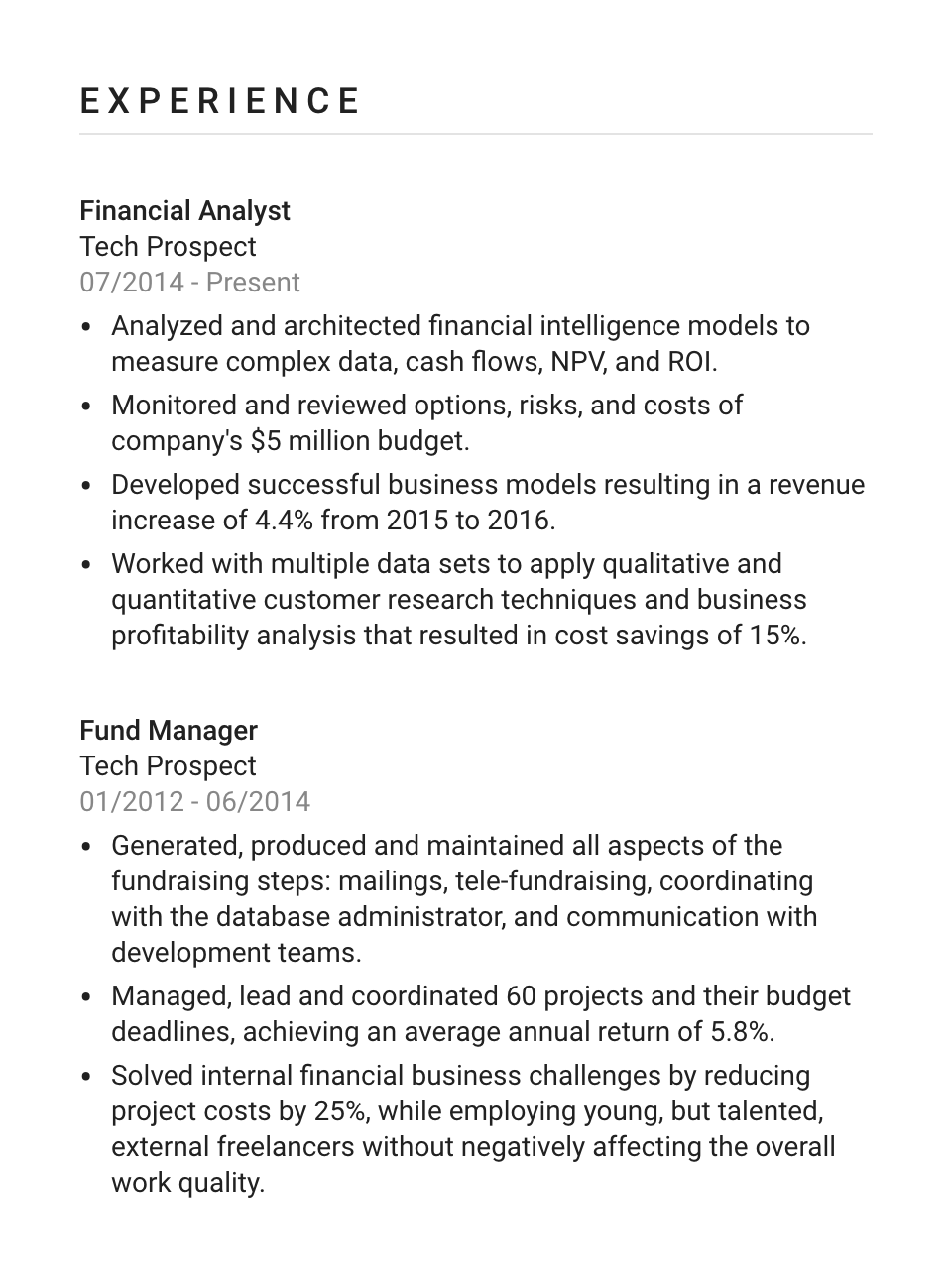
The first three points are self-explanatory, so let's jump into on how to write convincing accomplishment statements.
What are they? Well, first of all, they are not your job description or your previous duties. Your accomplishments are the results you managed to achieve.
While duty describes what you did, an accomplishment represents how well you did it.
Check out the two following statements to see the difference:
- Duty: I was responsible for generating advertising campaigns for different clients.
Accomplishment: Generated, produced and maintained 42 end-to-end marketing and PR projects of which three became viral stunts. All the projects were completed according to an approved budget, timescale, and expected quality.
Potential employers see past success as an indication for future performance, that's why this is the most essential part of your experience and your resume.
To put your mind on the right track, ask yourself the following questions:
- How can you be of benefit to the company?
- What are your unique skills and habits? What sets you apart? What do you do better than others?
- Are you consistent? Perseverant? Creative? Can you communicate well and take the lead? Are you very analytical?
- Which unique problems/challenges have you faced? How did you resolve those problems/challenges?
- Did you save your company money? Did you help your company to make money?
- Did you improve any processes, systems, or methods? Did you solve any problems?
Since we know now how to find out what you have accomplished, let's take a look at how to lay down your achievements in the most convincing way.
1. Start with an action verb
Achieve maximum impact by starting every sentence with an action verb that can lead to the scope or results of your activities.
Right (starting with an action verb): "Met 100% of goals as leader of cross-functional teams."
Wrong (starting with an adjective): "Skilled at leading cross-functional teams while meeting 100% of goals."
You can see how different each sentence sounds just by changing the structure.
What you shouldn't do:
- Don't start with "Responsible for" because it only describes your previous duties.
- Don't start with "Experienced in" because it shows that something happened, but not necessarily that anything was achieved.
- Don't start with "Two years' experience in" because the recruiter has already seen how long you worked at each company. You don't need to repeat it.
- Don't repeat the same action verb for every accomplishment, because it would only show your lack of vocabulary. There are many synonyms you could leverage.
2. Be specific and use numbers
In the job market, numbers speak louder than words, so use them to make accomplishments stronger. Numbers show that you understand business language and they provide the company with what they are looking for: employee results.
To illustrate your impact, consider sharing some statistics with regard to every single point in your experience section. Use a percentage, number of years, or amount of money to assure the hiring manager who is looking at your targeted resume that you're a high performer.
Market
Illustrate the impact your results had on the market. In fact, it's the easiest way to use numbers when your results are not dazzling.
- Supplied chain analysis in purchasing and inventory management worth $120M in an international market.
- Found innovative solutions and achieved goals in project management during 2008-2012 financial crisis.
Clients
If your accomplishments are not that impressive, use numbers to describe your clients instead of results. You can use this type of statement to show that, while you may not be the best, you are improving a trait that the job description requires. Consider adding such a statement at the end of your experience section.
- Implemented retail marketing plans for three years for two Fortune 500 corporations.
- Managed finances from $1.5M to $20M for several organizations.
Percentages
Percentages are one of the best ways to show results and impact. Don't worry if your annual service group growth was only 7%. Show it in any case, because the vast majority of candidates will just write about duties and responsibilities. The small increase you achieved is still a good result.
- Improved the UI of six websites, which decreased the average processing time by 14%.
- Reduced service costs by 5% using thorough data analysis.
Date & Time
Identify the time to show how long you benefited the company. That is the easiest way to include numbers in your statements, even if you only had a three-month internship.
- Increased monthly sales by $1,500 in two months.
Currency Amounts
Again, a good resume shows results, and there is no better proof of career achievements than numbers. They give assurance. Include dollars, euros, or whatever your country's currency is in at least one statement. Money is one of the most critical elements of business and an indicator of value.
- Earned the organization $6,000 using thorough data analysis.
3. Include a few key phrases from the job description
Companies are seeking for candidates with the most relevant experience. If you want to be a suitable candidate, you need to speak your employer's language. Scan the job description for the main skills an employer is looking for. Then, include those keywords in your accomplishment statements while presenting your results.
When an Applicant Tracking System scans your resume, it will find the matching key phrases and will give your resume a higher relevancy score. When a recruiter reads your resume, he/she will be looking at the application of a candidate who has better chances of fitting the job position.
Accomplishment Statement Examples
Sales:
- Worked independently and performed 80 - 100 daily cold calls, educating customers and building relationships.
- Increased unit sales goals by 260% and generated over $90,000 in revenue in six months without prior training.
Leadership & Management:
- Managed, lead and coordinated various teams of up to 70 people to perform marketing programs. This included collaboration both with internal and external teams.
- Solved internal financial business challenges by reducing projects' costs by 25% while employing young, but talented, external freelancers without negatively affecting the overall quality of the project.
Finance & Accounting:
- Saved up to 25% on shipping costs by generating accurate reports for determining the cost, quality, and location of the inventory, and maximizing production efficiency.
- Prepared monthly and quarterly investment forecasts of $4M stock exchange fund to evaluate precise margin call.
Analytics & Research:
- Analyzed and architected business intelligence models to measure ROI. Monitored and reviewed options, risks, and costs of company's $5 million budget.
- Successfully connected internal sales, marketing as well as design teams and departments with external partners via Trello and Slack integrations, leading to 20% more efficient workflow and effective data tracking and sharing of projects.
Have a look at many more resume accomplishment examples.
If you have 10+ years of work experience
Companies search for people who can perform daily jobs fast and bring profitable results. Whether you have no working experience, three years or 10+ years of experience, recruiters still search for the most relevant candidate.
More than ten years of experience show robust knowledge. On top of that, the relevant career experience is excellent proof that a new employee will perform his/her new role professionally. However, if you write about your 10+ years of career duties and responsibilities, your resume will be just too long, and, as a result, you might lose focus.
So, avoid writing about all your career duties. Identify the best career achievements that you can prove with numbers and forget about earlier career tasks which have no relevance to the current situation. Target your experience at the job position, make it short and concise to achieve the best result.
If you want to make a big career change
Some people are lucky enough to find their career path early on, but the majority of people don't discover their favorite job or industry right away.
When it comes to a career change, your resume should always be reworked to emphasize key skills. List those skills in the experience and skills sections.
Check the new job position's description and your previous career experience - find the skills with the most important transferable skill set. Target your best career achievements around these skills.
Furthermore, you should avoid objective or summary statements to explain your reasons for a career change. Instead, use a cover letter. A cover letter will give you the opportunity to explain the reasons and motivation for your personal decision to change a career path.
Key Takeaway of Experience Section
To list your experience in the most convincing way, you should:
- Read and understand the description of the job you are applying for. Do a little research on the company.
- Pick out relevant and important phrases and keywords.
- List your strongest accomplishments relevant to a job position.
- Start every accomplishment statement with an action verb, be specific, use numbers, and Include a few key phrases from the job description.
Awesome! You have just nailed the hardest resume section!
Chapter 5: Education
The education section always follows the experience section, because recruiters are more interested in your job-related, not academic, achievements.
However, education matters. It shows your intellectual potential, how prepared you are and which professional subject matters are important to you.
List all your education with the highest or the most recent degree placed first.
Every item of education is made of:
- Field of Study
- Name of the institution
- Graduation Year
- Degree

Note: Don't include high school if you have completed higher education or have relevant job experience.
If you're a recent graduate and you don't have relevant job experience or no experience at all, you should list what you have accomplished during your education – using the same techniques examined in the previous chapter about experience accomplishments. List the most notable distinctions or awards you have achieved:
- Achievements at campus or organizations.
- GPA (if it were one of the best in your class).
- Mention your top college projects, group works, or any other relevant practices.
Prioritize your achievements based on the job requirements, and place them at the top. Start with an action verb, be specific, use numbers, and include the key phrases from the job description.
Note: If you lack formal education or a degree but have participated in training, courses, free seminars or conferences, list these achievements in the education section as well.
Chapter 6: Targeted Skills
Employers search for employees who can be of benefit to the company in a specific area. More than anything, employers want employees with solid skill sets and competencies who can help the company beat competitors and generate a higher profit.
The experience and skills sections capture on average 70% of the recruiter's attention while the education and other parts of the resume are scanned more carelessly.
With that in mind, it is paramount to highlight skills that showcase your best characteristics, as well as those that add value to the company.
Identify and describe your characteristics and strengths in such a manner so that it becomes the most professional list of skills.
Two types of skills should be included in every resume are hard and soft:
Hard skills are based on IQ and are the specific qualifications required to perform a particular job. For example, "project management", "sales", or "graphic design". Hard skills are qualifications that are developed by working a specific job.
Soft skills are based on personality traits and can be applied to every job. They are referred to as "people skills" or "transferable skills", such as passion, the ability to communicate well, positivity, or energy.
You need to target skills at a particular job position like anything else on your resume.
Targeted skills are qualifications that focus on a specific job and a company, and they are a combination of hard and soft skills, differing from one resume to the next.
Scan through the job description of the position you are interested in and identify important keywords that match your profile and work experience. These are the best hard and soft skills for your targeted resume. Select the top 10 – 20 skills to target your resume, (just do not copy the job ad).
You can find out required skills automatically by using our targeted resume builder.
The skill that is most desired will be listed directly in the headline/title of the job description itself. For example, "Looking for Project Manager", "Graphic Designer Wanted" etc.
Here's how your skills section could look like:
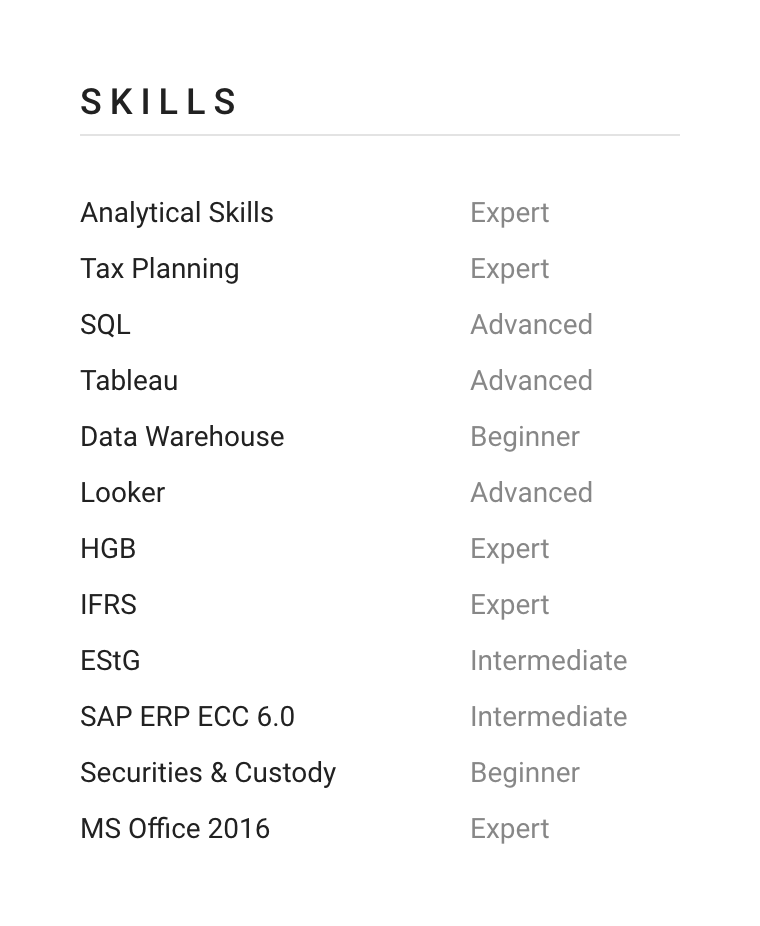
Skill ratings
Personal skill ratings are really subjective, that's why we don't recommend using scales or numeric evaluations, like 8/10. Instead, use words such as Beginner / Intermediate / Advanced / Expert. These ratings will be more logical and will use the same dictionary as it is usually used in job postings.
What soft skills to put on a resume?
Some soft skills are generally required by most companies worldwide. Check them out bellow and see if you can apply any of those to your resume as well.
Time Management
The ability to manage time efficiently indicates that you can lead a variety of projects with adequate knowledge of deadlines and expectations. By including this skill in your targeted resume, you show potential employers that you are organized and know how to avoid last-minute stress caused by procrastination.
In the modern era, time management is a crucial skill in nearly every profession. Be sure to mention keywords such as short-term and long-term projects in your resume, and give a recruiter real examples of how you have demonstrated this skill in the past. As always, show it, don't just tell them about it.
Synonyms for time management: punctuality, adaptability, deadline control, time planning.
Energy
If you are upbeat and enthusiastic, you should include a characteristic such as energy on your targeted resume. According to most CEOs, this is one of the most important soft skills an employee can have.
Demonstrating a positive attitude each day inspires and motivates other team members, and can aid in climbing the career ladder in the long run. Of course, if "energetic" doesn't quite describe you, the best way to improve your attitude is through physical activity, which could boost your health as well as your employability. Motion creates emotion :)
Synonyms for energy: positivity, positive attitude, dynamic, enthusiastic, and fast thinking.
Communication Skills
Adequate communication is one of the top qualifications valued by all employers. Communication skills allow employees to express their needs and work towards goals with co-workers and superiors – saving time, building relationships, and increasing productivity.
Whether you exercise your social skills through spending time with friends, visiting local bars, or any other means, social skills are necessary for any job and can be easily practiced. All you need is a group of people and a reason to chat.
Synonyms for communication skills: teamwork, collaboration, interpersonal skills, emotional intelligence, and multicultural sensitivity/awareness.
Agility
Being adaptive is crucially important for all careers where projects and expectations change every month – and sometimes every week.
To adapt to the rapidly-changing demands of modern work, young employees also need to demonstrate agility – definitely a useful and professional skill to put on your targeted resume.
Synonyms for agility: promptness, adaptability, resilience, sharpness, and critical thinking.
Integrity
In corporate culture, integrity is a highly valued characteristic. Loyalty to your job indicates that you see yourself in your respective field for at least several years. For an employer, hiring employees is a huge investment. In fact, it costs an average of $4,000 and takes around 52 days for every new hire.
Thus, to reduce both the time and the cost of hiring, it benefits the company to find a candidate with integrity and work experience highly relevant to the position.
From the perspective of CEOs, two integrity skills most employees lack are:
- Always doing what you say you will do (being reliable).
- Keeping track of yourself and your projects.
Being reliable means that you can manage yourself, be organized, and prioritize what is important.
Synonyms for integrity: honesty, disciplined, responsibility, strong work ethic, and self-awareness.
Perseverance
Time management and perseverance are pivotal, especially when performing time-sensitive projects. A willingness to sacrifice evenings, weekends and leisure activities demonstrates your dedication to and faith in the success of the project. It's a top-paid skill in the modern world and a key component of leadership. If you feel you have this professional skill, include it in your targeted resume.
Synonyms for perseverance: attention to detail, willingness to learn, reliability, work ethic, initiative, and creativity.
Leadership and Management
Leadership is one of the most valuable skills an employee can have as it indicates the ability to complete work on time, work under pressure, and to make calculated decisions while managing the often stressful needs of a team.
Including such a skill on your targeted resume requires that you have experiences that demonstrate your ability to lead successfully. Be sure to stress your proof of leadership in your cover letter or during an interview if you have this skill.
Synonyms for leadership/management: planning and organization, negotiation, contract negotiation, strategic thinking, strategic planning, technical sales, risk management, risk control, business analysis, business development, and critical thinking.
Chapter 7: Additional Resume Sections
Languages
List all the languages you know. You can also rate them as your skills, choosing one of the following four levels: Basic, Intermediate, Fluent, or Native.
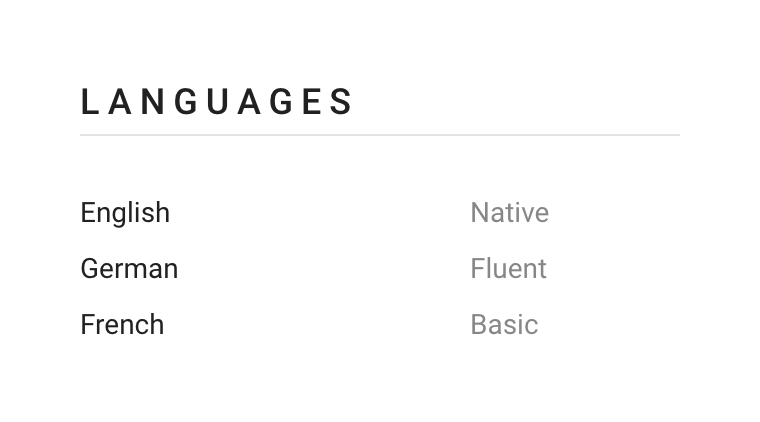
Certifications
List all the certificates that are relevant to the job you're applying. Provide the name of the certificate and its duration.
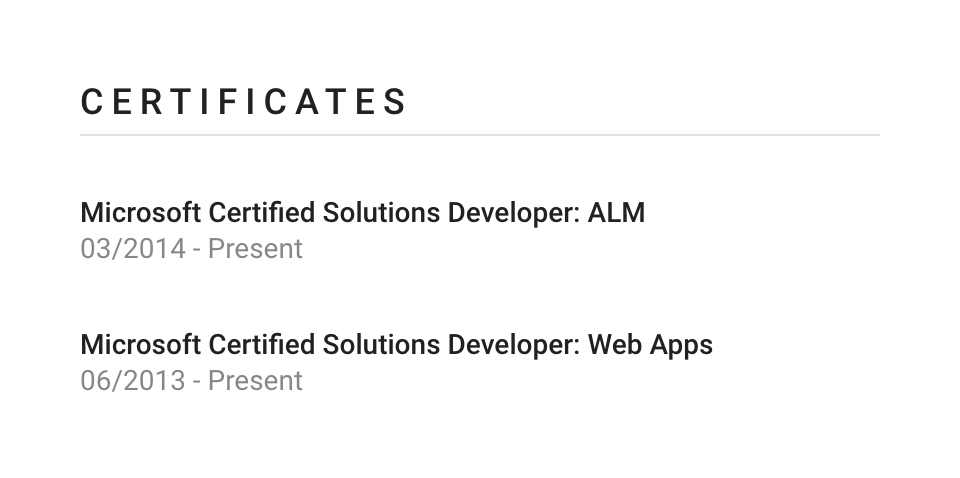
Avoid any other sections
Do not include any other information such as Hobbies, Interests. etc. This is unnecessary information that doesn't provide any value to you as a candidate since companies are searching for people who match the job requirements. Leave such topics to discuss during the job interview.
Chapter 8: Sending Out Your Resume
If you've followed all the chapters in this guide, your resume now should look just fabulous! The last thing you have to do is proofread and review it.
Proofread your resume. Half of all resumes are thrown out because of grammatical errors. That is why you should thoroughly reread your targeted resume a few times and make sure that the content is grammatically correct. You can ask someone else to check your resume's text as well.
Review your resume. Read every line of the position's job description and compare it to your resume. Does the context match? Do you look like a person who can fulfill the company's needs? It is crucial to answer yes. If you see that there are areas in your resume that you can make more relevant to the employer, go back and refine them. You can ask another person to review your resume briefly and compare it to the job description. Your friend's opinion about key points might simulate the first impression of the recruiter's.
Write a cover letter. A well-written cover letter gives you a chance to tell the story behind your resume's key statements, and explain why you are the ideal candidate. That's why you definitely should write one.
Name your resume file descriptively. Do you know how many resume files have a generic, anonymous file name like "resume.pdf?" A lot! Help your prospective employer to find you more quickly by giving the resume file a specific name like "John Black - Marketing Manager.pdf".
When you have your resume and cover letter ready, contact the recruiter directly.
You can find any employer contact information on the Internet very quickly using websites like LinkedIn. You can find HR managers who have posted job positions as well as the names of managers and supervisors you would be working for.
Write an email to the recruiter of the company that you are interested in and inform him/her that you want to apply for the job position. Here's an example of how such an email could look like:
Mr. John Black,
The purpose of this letter is to explore employment opportunities with XYZ and apply for the Project Manager position. The resume included will furnish you with the details concerning my experience and capabilities.
Thank you for your time to get to know me.
Yours sincerely,
Peter Richards
And that was it! Congratulations! Now you should have a perfect resume and a strategy to contact a recruiter.
The Bottom Line: Make Your Resume Relevant
Recruiters get hundreds of requests for each open job position, and that is why they can't dedicate enough time to review long applications thoroughly. They search for the best candidates by quickly scanning resumes for keywords and key phrases associated with a particular job opening.
Recruiters tend to prefer a targeted resume, which is short and to the point, because it's easier and faster to see the bigger picture of the candidate.
Focus on writing short and targeted statements instead of an extended list of every job duty you have ever had. Put your essential and most relevant information on a resume with your best accomplishments and targeted skills strategically located in the first half of a page.
Employers don't want to know all of your previous duties and responsibilities. They just search for a person who can solve specific business problems. That's why you should focus more on the quality of your content than the quantity:
- Your resume is not a comprehensive biography of your life. It should simply show that you can fill a company's needs in a particular job position.
- Read job descriptions to understand what employers are looking for.
- Put your most substantial accomplishments at the top of each resume section.
- Don't include irrelevant information.
- Tailor each accomplishment to the job description in the ad.
- Use keywords to demonstrate your relevance to the company. You can Wozber to find the keywords automatically.
- Use numbers to quantify results you have achieved.
- Use our free resume builder to layout your information.
- Reread the job description and review your resume.
- Contact the recruiter directly and inform her/him of your candidacy.

